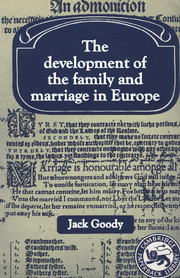Book contents
- Frontmatter
- Contents
- List of figures, maps and tables
- Preface
- 1 Perspectives
- 2 Two sides to the Mediterranean
- 3 Change in the German lands
- 4 Cousins and widows, adoptees and concubines
- 5 From sect to Church
- 6 Church, land and family in the West
- 7 Reformation and reform
- 8 The hidden economy of kinship
- 9 The spiritual and the natural
- Appendix 1 Kin groups: clans, lineages and lignages
- Appendix 2 From brideprice to dowry?
- Appendix 3 ‘Bilaterality’ and the development of English kin terminology
- References and bibliography
- Glossary
- Index
7 - Reformation and reform
Published online by Cambridge University Press: 05 June 2012
- Frontmatter
- Contents
- List of figures, maps and tables
- Preface
- 1 Perspectives
- 2 Two sides to the Mediterranean
- 3 Change in the German lands
- 4 Cousins and widows, adoptees and concubines
- 5 From sect to Church
- 6 Church, land and family in the West
- 7 Reformation and reform
- 8 The hidden economy of kinship
- 9 The spiritual and the natural
- Appendix 1 Kin groups: clans, lineages and lignages
- Appendix 2 From brideprice to dowry?
- Appendix 3 ‘Bilaterality’ and the development of English kin terminology
- References and bibliography
- Glossary
- Index
Summary
The Renaissance in Europe saw a dramatic change in the position of the Church, both culturally and economically. In the world of art the great princes of Italy, the merchants, bankers, warriors and landowners, became the dominant supporters. Drawing their wealth from the increased trade of the Mediterranean accompanied by a growth and diversification of productive activity, they took over much of the role previously played by the Church. The shift of patronage was linked to a change in content, the religious themes of medieval art being supplemented, in many ways replaced, by the portraits of Piero della Francesca, the classical subjects of Botticelli and the detailed landscapes of the Flemish painters whose new use of oils changed the tonality of expression. The process of secularisation affecting the graphic arts was a symptom of a wider process of demythification, rationalisation and reform, which had been stimulated by changes in ways of communicating, of exchanging and of producing.
But the tradition of reform had more popular and long-standing roots, and at this level protests against the acquisition of property by the Church formed a continuing refrain in European life. Some would regard the eleventh century as signalling the origin of European dissent, at least in terms of ‘popular heresy’ (Moore 1973: 3), though others would insist that it was contained in the womb of Christianity, manifested itself in the early schisms and was well in evidence by the eighth century (Russell 1965).
- Type
- Chapter
- Information
- The Development of the Family and Marriage in Europe , pp. 157 - 182Publisher: Cambridge University PressPrint publication year: 1983

